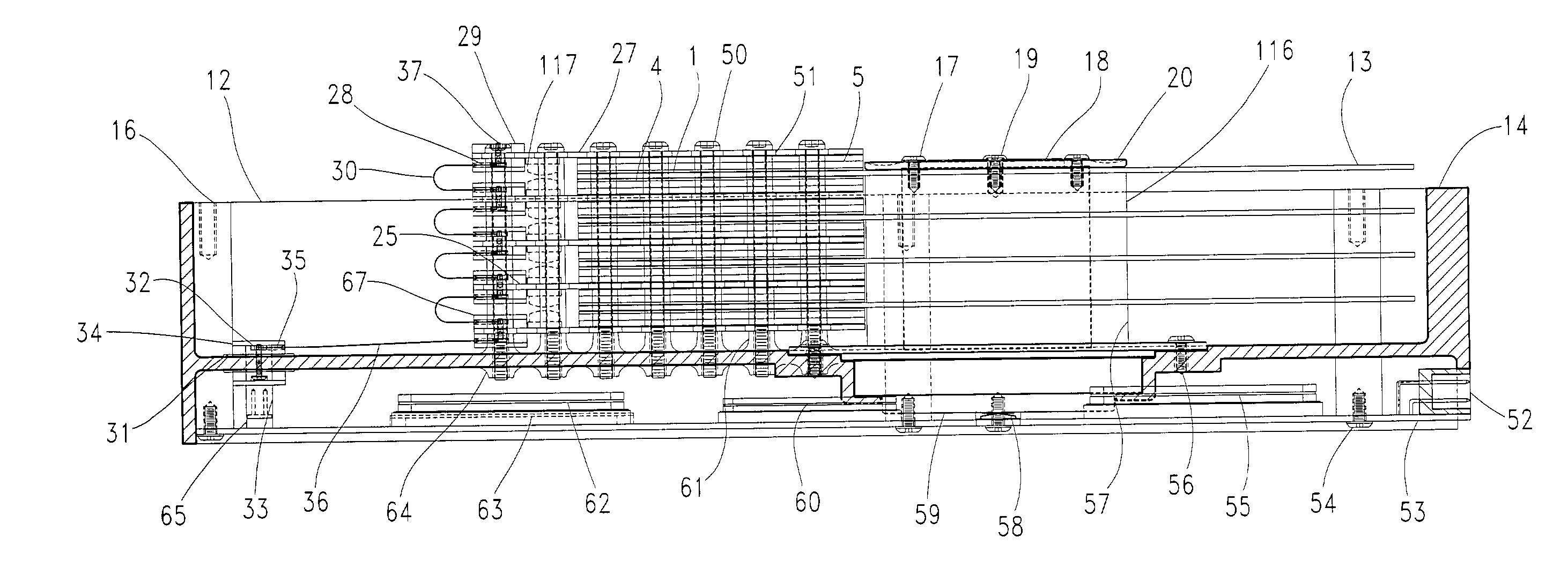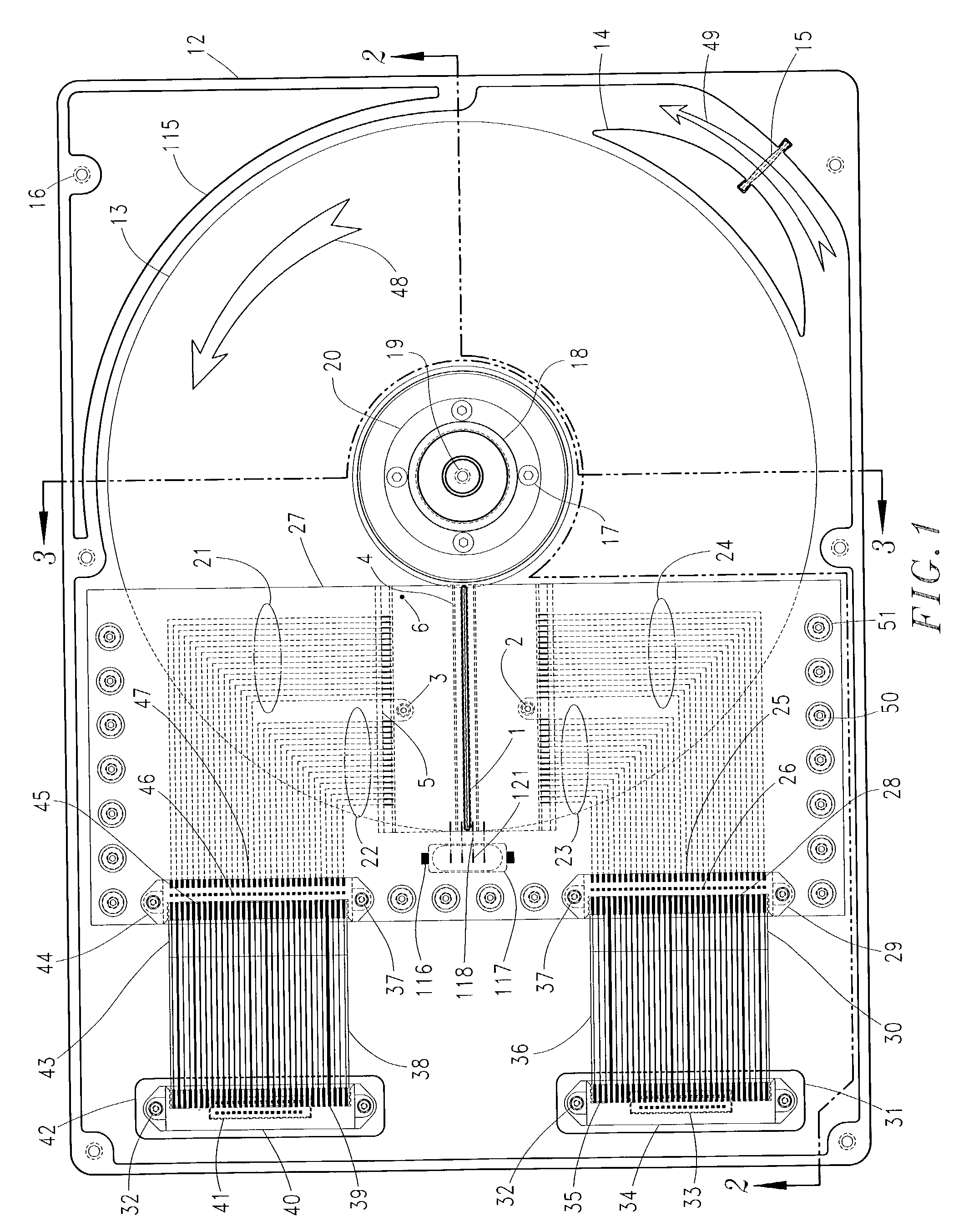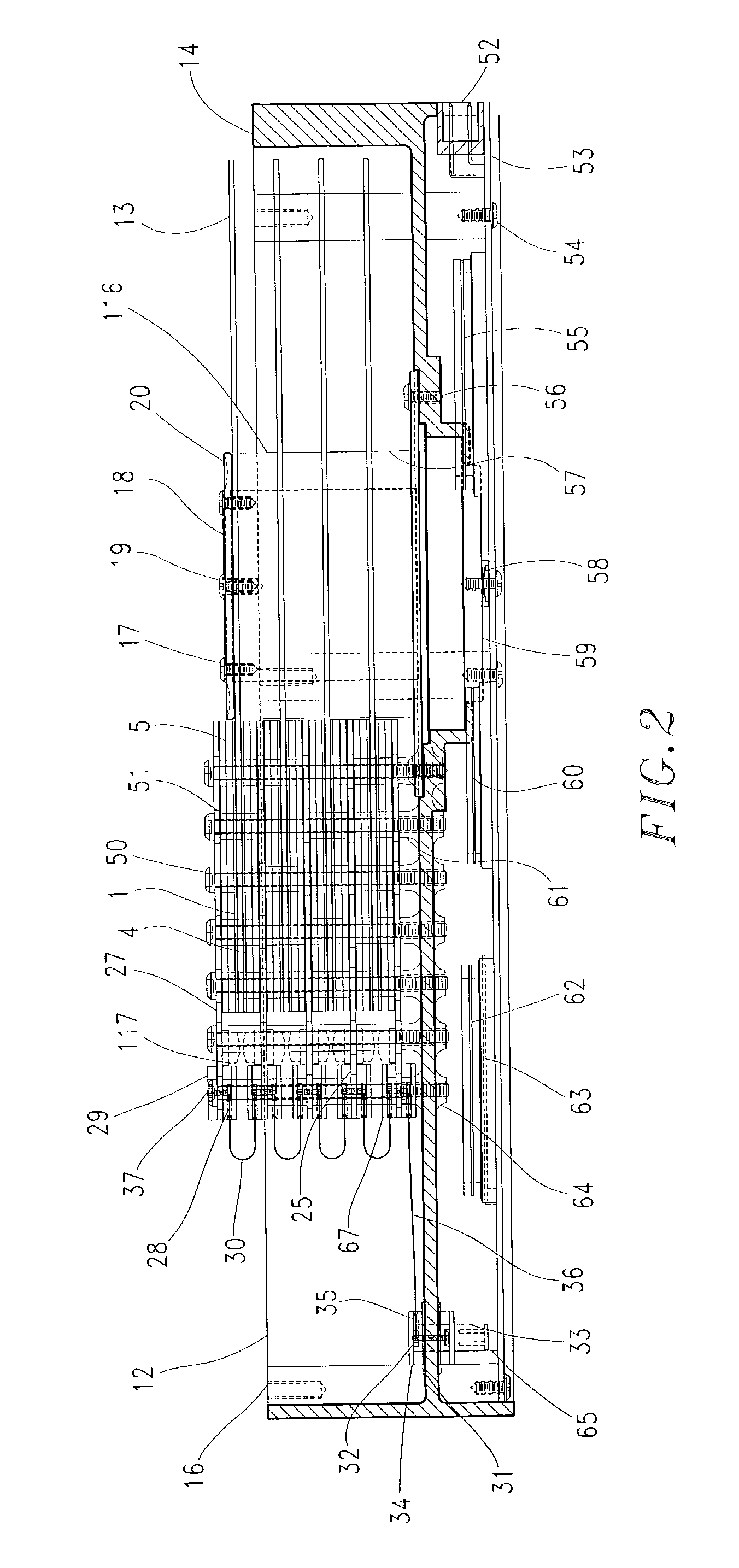Furthermore,
magneto-
optical storage media are characterized by their extremely reliable, fast, and substantially unlimited rewritability.
Moreover, as prior art shows, the maximum
data density that can be achieved for magneto-optical media is limited on the one hand by the minimum size of the magnetic domains and on the other hand by the
optical resolution of the
laser optical
system.
Because the minimum size of the magnetic domains is significantly smaller than the
optical resolution of conventional
laser optical systems, being proportional to the
wavelength of the
laser used, the storage density ultimately is limited by the resolution of the laser optical
system.
It, however, is very difficult to dispose a second
magnetic field generator under the condition that a magnetic field having intensity sufficient to prevent the contact of the initializing magnetic field generator and the recording medium when it is applied to the recording medium.
Actually, as prior art shows, in a conventional apparatus using an ISO 3.5-inch type
cartridge containing a magneto-
optical disc media, the opening of the
cartridge is too narrow to provide two magnetic field generators.
If magnetic field generators are forcibly provided in the opening, the intensity of the magnetic field generated by the initializing magnetic field generator is larger, so that the magnetic field leaks into an objective lens
actuator (i.e., focusing lens
induction coil) and the objective lens moves abnormally.
Furthermore, the magnetic field generated by the second magnetic field generator is affected by the magnetic field generated by the initializing magnetic field generator, so that the intensity of the magnetic field generated by the second magnetic field generator cannot be controlled to the desired value.
However, as prior art shows, typical magneto-
optical recording media have the following various problems.
They require a separate source of generating a bias magnetic field in a recording mode and this has increased the complexity of the equipment.
In addition, as prior art shows, there is a second problem with typical prior art magneto-
optical recording media, and that is the exchange force acting between the first and second magnetic
layers is strong at a temperature where the
magnetization of the first
magnetic layer is aligned to the direction of
magnetization of sublattices of transition metals in the second
magnetic layer whereas it is necessary to reduce the exchange force acting between the first and second magnetic
layers in the process of initialization at a temperature near
room temperature, and because of this small
latitude in adjusting the thickness of the first and second magnetic
layers, it has been difficult to achieve consistent production of reliable magneto-
optical recording media.
Typically, magneto-optical
recording media, as prior art shows, have a sufficient Kerr magneto-optical effect for satisfactory
reproduction output at or near "800" nanometers, which is currently used to operate the optical head but if the operating
wavelength is reduced by half to "400" nanometers, the
angle of rotation will decrease to less than a half of the value that is achievable at "800" nanometers and no satisfactory
reproduction output can be obtained.
Moreover, a further problem with the prior art magneto-optical
recording media capable of light-modulated direct overwriting is that they require a strong bias magnetic field in order to compensate for the spurious magnetic field originating from the fourth layer.
In addition, the magnetization of the fourth
magnetic layer is reversed during illumination with P.sub.H, thereby making it impossible to perform another overwriting.
Furthermore, another issue confronting the designer of a hard disk drive
system is data-head positioning, and data-
block transfer-rates.
Consequently, when
servo-information is embedded on a data-surface formatted for `Zoned-Data-Recording`, several complications may arise in the reliably of providing robust
servo-head positioning information.
Typically, if the servo-information is recorded at the same data-rate while in positional relationship with the recorded data-blocks, as has been conventionally employed in prior art, servo-architecture is normally complex enough to switch data-rates and servo-positions.
However, if regularly spaced servo-information were radially placed across data-storage disk-platter data-surfaces, while splitting some of the data-fields, located on the aforementioned data-surfaces, into segments, data-zones, when crossed-over, could cause serious complications to arise when trying to read each `Split
Data Field` as a single data-block.
Furthermore, the beforementioned disk-platter's rotational velocity must be constantly monitored and carefully maintained at a predetermined
constant angular velocity for the aforesaid `Split
Data Field` scheme to function properly; therefore, adding additional complexity to the servo-
tracking system.
However, some hard disk drive designs do not use, or normally include within their designs, the complication of Zoned Data-Recording and Split Data-Fields.
However, this leads to a tremendous level of
bus-traffic control between a supervisory
microcontroller and a
Disk Controller's Data Sequencer, during a hard disk drive's read-data or write-data disk-operations.
However, during host-requested LIMDOW and MSR
Magneto-Optical Microhead Array
Chip Hard Disk Drive's disk-operations mechanical movements of the beforementioned LIMDOW or MSR Magneto-Optical Microhead Array Chips'
diode laser or
diode laser or VCSEL microheads, from one
concentric cylinder / track to another, is unnecessary.
Furthermore, during a read-data or a write-data disk-operation and in case of errors a "Sector-ID" is neither read nor corrected increasing the overall data
throughput for the hard disk drive.
Furthermore, about 60% of all conventional flying-head hard disk drive fatal-error crashes (i.e., sometimes called a catastrophic hard disk failure) are catastrophic and are typically the result of Rotary Voice-Coil and / or Spindle-Motor mechanical malfunctions or failures.
When examining this problem further, we find that flying-heads, in striving to maintain today's critical flying-height distance of "0.5" to "2.5" microns above disk-platter data-surfaces on what is sometimes called an "air-bearing", the beforementioned flying-heads can be caused to easily make physical contact with data-surfaces, for example during a catastrophic hard disk fatal-error or
crash, which will always result in
data loss (i.e., sometimes called a catastrophic
data loss).
In fact, within a conventional rotary positioned flying-head hard disk drive design, a head-slider's
flight distance, which is today normally "0.5" to "2.5" microns, would be difficult, if not impossible to achieve, were it not for the aerodynamic design of conventional flying-head head-sliders and the air-bearings that they produce.
Furthermore, fatal-error hard disk drive crashes most often occur when a Spindle-Motor's power supply fails, or the hard disk drive, during a read-data or write-data disk-operation, is suddenly shaken or dropped, while the hard disk drive's head-stack
assembly has not been properly repositioned into an innermost disk-platter area (i.e., sometimes called the head-stack
parking area), but remains located over a data-surface when any of the malfunctions mentioned occurs.
Consequently, during a power-supply failure a hard disk drive's Spindle-Motor will lose its
momentum and begin to spin down; wherein, the head-slider air-bearings will begin to decay, and no longer maintain necessary
aerodynamic lift for the beforementioned head-sliders.
Therefore, a conventional flying-head hard disk drive's head-stack
assembly, not being repositioned into said head-stack
parking area, and being subject too complete loss of head-slider air-bearings, the beforementioned hard disk drive flying-heads will make physical contact with the beforementioned disk-platter data-surfaces; ultimately, crashing into the data-sector areas located on the aforesaid hard disk drive's data-surfaces; moreover, destroying any previously recorded data therein.
Furthermore, the root-cause behind many hard disk drive failures is a
Disk Controller's failed
BIOS system or
BIOS system-
chip, or a Spindle-Motor's power-supply malfunctioning.
Nevertheless, whatever the root-cause might be, the end-result is always the same, hard disk drive crashes and severe data-loss.
 Login to View More
Login to View More 


